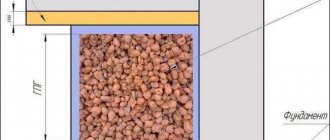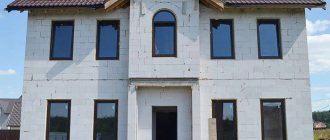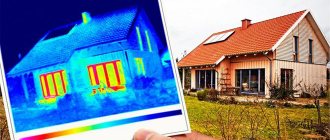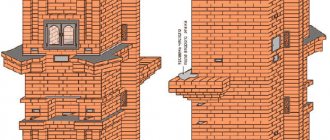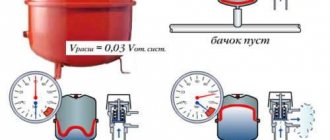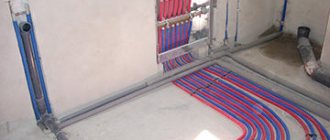Advantages and disadvantages of the system
Today, the use of electric heaters is becoming increasingly popular. In a wooden house, this option is the most relevant only if there is no gas on the site (there is no main line).
The advantages of electric heating are as follows:
- With the correct location of electric heaters, the efficiency of the system will be many times higher than with a stove or water option (you can clearly see this advantage in the circuit diagram below).
- There are no harmful emissions into the atmosphere (unlike the stove version), and there is no need to install a chimney.
- Ease of installation (for example, you can easily install an electric boiler or IR heater with your own hands).
- A modern approach to control (the use of electronic thermostats and other devices that make the electric heating system in a wooden house fully automatic).
- Repair of an electric heating system occurs extremely rarely, especially if all devices are made by quality manufacturers.
- There is no need to store firewood, coal or other types of fuel.
- Cost-effectiveness of the system (we'll talk about this below).
- The absence of radiators and pipes throughout the room, which has a positive effect on the speed of installation of the system, as well as the interior of all rooms.
- Compactness of electric heaters.
- Electric heating in a wooden house can be used as main or backup.
As for the disadvantages, the main ones are:
- The electrical network supplied to the house can often be turned off for repairs and maintenance (especially in remote areas of the city). No electricity - no heat.
- The need to install a diesel generator, which will allow us to get out of the situation described above for some time. The cost of this unit is quite high.
- Without the use of multi-tariff meters and other devices that save energy, the system will cost you much more than alternative options.
- Electric heaters, especially infrared ones, are fire hazardous devices. There are many requirements for their connection and installation location.
You can see what one of the options for electric heating in a wooden house looks like using a visual example:
Installation features
As we have already said, when connecting electric heating in a wooden house, you must adhere to several important requirements, namely:
- When heated, wood can dry out and crack, so avoid direct contact with the heat flow on the walls and ceiling. It is best to point the devices towards the floor and towards the center of the room.
- If you decide to use radiators, their installation in a wooden house also has its own peculiarities. Over time, wood shrinks. If you do not provide special compensators on the risers in the design of the house, during shrinkage the heating main may be disrupted and fail.
- The power cable from which the electric boiler (or boiler) will be powered must be able to withstand current loads with a reserve. Otherwise, ignition may occur from spontaneous combustion of the electrical wiring. To prevent this from happening, calculate the cable cross-section based on power.
- When using UV intensifiers, place them in such a way as to prevent direct (or very close) contact of the heating element with other objects.
Fire safety rules when installing gas heating
When installing gas heating in a wooden house, there are requirements that must be met. If you ignore them, the likelihood of a fire will increase significantly. It is important to consider the following:
- Between the gas boiler and the wooden wall or floor there must be a shield made of fireproof material - galvanized steel or asbestos. The dimensions of the substrate must exceed the dimensions of the unit on all sides by at least 10 cm.
- All electric and other heating elements are located at a distance of at least 30 cm from the gas boiler. Electrical wiring must not be installed above or below the device.
- The diameter of the chimney must correspond to the boiler pipe. A pipe made of stainless steel should be used.
- The opening for the chimney must be larger than the diameter of the pipe, since it should not touch wooden surfaces. It is necessary to install an additional layer of insulation using asbestos or a piece of cement-asbestos pipe.
- The room where the boiler is located must be well ventilated and have an opening window.
- The mounted unit cannot fit closely to the walls; the gap is 10-20 cm.
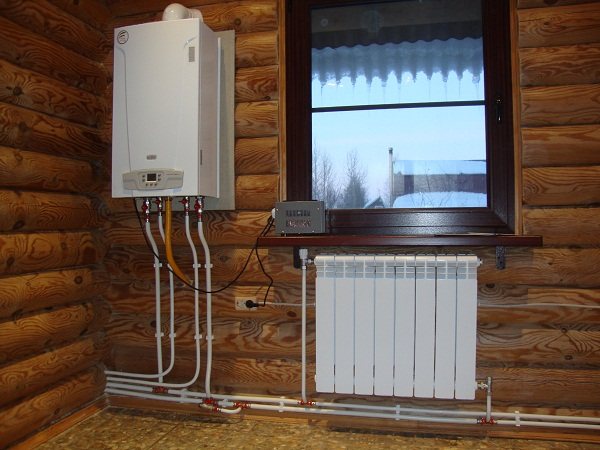
When installing a conventional chimney, insulation should be installed at each point where the pipe passes through the ceiling. It is recommended to purchase a ready-made, thermally insulated sandwich-type chimney that meets fire safety standards.
Thus, organizing gas heating in a wooden house is quite possible. It is only important to comply with certain fire safety requirements so as not to put the health and lives of your loved ones at risk.
Heating system options
We can’t help but talk about what kind of heaters can be used to install heating in a wooden house with your own hands. Let us consider in detail the most effective and common options for everyone.
- The use of water heating, in which heating occurs with an electric boiler. The option is the most popular, but not the best in terms of efficiency. The disadvantage is that you still have to install a pipe line, especially since, as you saw in the diagram, the radiators do not heat the room very effectively (warm air rises).
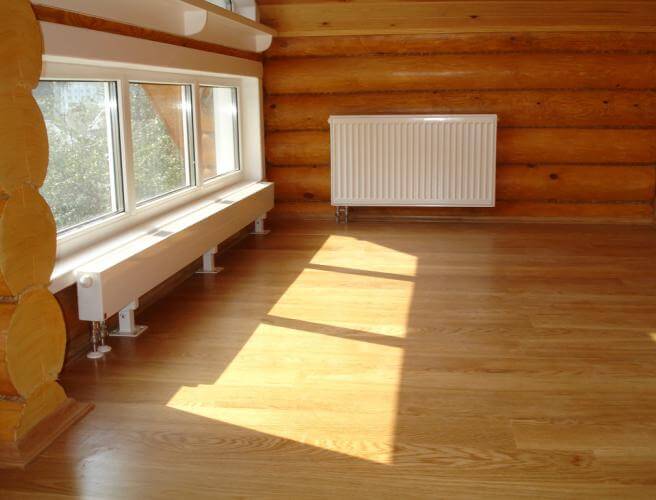
- Using a boiler for heating. You will be surprised, but this system is also popular and has proven itself very well, judging by the reviews of its owners. The main requirement is that the heating system must be simple and the area of the room small. By the way, in this case, a storage type boiler is used, not a flow-type one.
- Connecting infrared wall and ceiling heaters. This option for electric heating of a wooden house is more effective, this was confirmed by the picture, which clearly shows that warm air is directed from top to bottom, thereby completely warming up the entire room. Moreover, in this case, installation work is reduced to a minimum, because all kinds of pipes and radiators will be absent.
- Installation of "warm floor". This system is an innovation in the world of electric heating. Warm floors are quite effective, economical, and most importantly, safe to use. The only drawback is the laboriousness of the installation work, but still the end justifies the means. We talked about how to make a warm floor in a wooden house in a separate article, where various installation diagrams were also provided.
- Use of oil radiators. Can be used as a backup or auxiliary option. The use of oil radiators as the main heating will hit your wallet too hard, because... for an entire wooden house you will need at least 1 piece/room, and the price for electricity today is quite high.
In addition to the above equipment options for electric heating in a wooden house, you can also use electric convectors. We have already told you how to choose the right electric convector. Our advice is to give preference to the combined option. A wooden country house is best heated with a boiler or IR heaters in combination with the “Warm Floor” system, as shown in the photo below!
How to make water heating in a wooden house
There are several options for designing this heating system, each of which has its own characteristics. One of the popular and modern solutions is water floor heating in a wooden house. In this case, the pipes are laid under the finishing coating, which further reduces the space they occupy. At the same time, the system turns out to be hidden and does not affect the attractiveness of the interior appearance of the rooms, allowing you to implement a wide variety of original and stylish design solutions.
No less often used is the option in which the pipes are mounted along the internal walls of the building. In this case, the wiring is done with the device:
- horizontal riser. The simplest and cheapest method, often used for heated floors;
- vertical riser. A more complex and expensive system, which has undoubted advantages, which include uniform and efficient heating of all rooms of even a very large building.
An equally important decision that should be made before installing water heating in a wooden house is the choice of pipes used in the system. The most popular options currently are plastic products, which are made from polyethylene or perchlorovinyl. They have fairly high strength and other operational and technical parameters and characteristics. However, there are some disadvantages, the main one of which is the possibility of freezing of the system. To avoid this, it is recommended to use antifreeze instead of water in the cold season. This is a specially developed composition that is practically incapable of freezing.
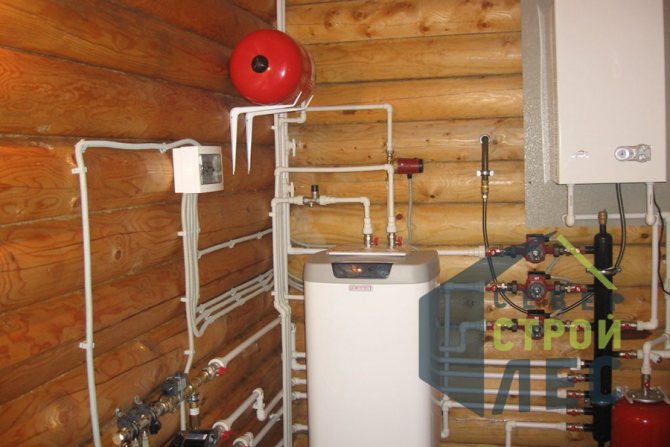
Less often, steel pipes are used for water heating of wooden houses. Their main disadvantage is their susceptibility to corrosion, and more resistant galvanized or stainless steel products have a higher cost.
Finally, pipes made of copper have the highest performance parameters. They are durable, not subject to corrosion, and have the ability to easily withstand very significant surges in pressure and temperature inside the system. However, their widespread use is hampered by their extremely high cost.
What can you save on?
So, you have decided on the option of electric heating for a wooden house, now you need to select the right equipment and calculate the project in such a way that all elements are used as efficiently as possible.
First of all, correctly calculate the power of the equipment. It is believed that for 1 m3 of insulated room, sufficient thermal power is 30 W (for an unheated room 41 W). This calculation is simplified; for a better calculation, it is recommended to use special formulas and programs that can be easily found on the Internet.
Next, make sure that all heaters have a temperature regulator. This device will allow you to set the optimal temperature in the room. As a result, electric heating of a wooden house will not be so expensive. Another important piece of advice is to purchase a two-tariff electricity meter; we talked about its advantages in the article we referred to.
Well, the last thing I wanted to note is to make sure that the house is well insulated. All cracks under windows and gaps in doorways must be repaired. Wood itself is a heat-intensive material, so a high-quality insulated building will reduce energy consumption by at least 2 times.
samelectrik.ru
Heating in a wooden house
A house, including one built of wood, is heated according to one principle - a heat generator (TG) produces thermal energy, and the coolant distributes it throughout the rooms. Boilers, stoves, fireplaces, and so on act as heat generators. The coolant is air or water. To some extent, infrared radiation plays the role of a coolant, but its efficiency is much lower than that of air or water. Therefore, all types of heating are divided according to the method of obtaining thermal energy and the method of transporting it around the house.
Electric heating in a wooden house
One of the most common solutions for heating a wooden frame house is the use of electricity. The most popular electrical equipment for a heating system is the boiler.
The unit is equipped with a tubular element (heating element), with its help, electrical energy is converted into thermal energy in a short period of time. The heating element is located in the container of the heating boiler, where it comes into contact with the coolant. The latter, after being heated by the heating element, begins to circulate along the circuit of the heating system and transfer heat to the heating devices.
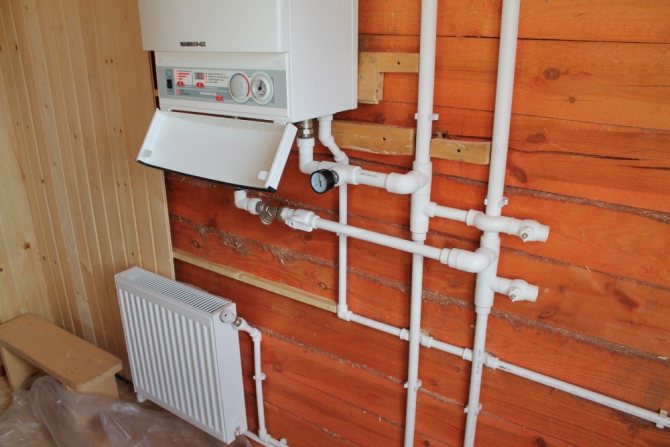
Electric heating of a wooden house
In addition to electric boilers, the heating equipment market offers other methods of comfortable heating with electricity. Mention should be made here of heaters, ultraviolet radiation, and oil heaters. All these heating devices have both many positive aspects and significant disadvantages.
Tip: The disadvantage of electrical appliances is mainly the high level of electricity consumption.
If you use electric heating at home as the main, rather than additional, source of insulation, then expect quite large sums for electricity consumption at the end of each month. Also, in suburban areas, power outages often occur, which can affect the quality of heating at home.
Electric heating will be fully justified for installation if the house does not have the possibility of connecting to a gas main.
Types of heating systems
Gas:
- air;
- water
Electrical:
- convection;
- water;
- air.
Liquid fuel:
- water;
- air.
Solid fuel:
- bake;
- heater;
- boiler.
Features of air and water heating
Regardless of the type of energy on which the TG operates, air and water heating are based on the same principles. Both types of heating can be either natural (EC) or forced circulation (PC). EC heating operates on the effect of changes in coolant density as a result of heating. Heated water or air moves upward, then slowly and smoothly descends. To move water, pipes with a diameter of 2–2.5 inches are used, the air duct cross-section is at least 1500 cm².
Then the pipe or air duct goes into the rooms, gradually losing height (1–2 cm per 1 meter). In the room, a pipe goes down to the radiator, and an air duct to the floor. The water, having given up heat to the radiator, returns to the TG through the return pipe. Air entering a room increases its pressure, which leads to the movement of air masses. Some of them exit through the cracks and go into the atmosphere, the other part moves from room to room and enters the room with the TG. In air heating systems with EC, it is difficult to ventilate rooms, because the speed of air movement is low, so the air flow will not be able to entrain clean air from the street.
For the PC, a pump is installed that accelerates the coolant to the required speed. Thanks to this, a pipe with a diameter of 10–20 mm is used for water heating, and the cross-section of the air duct is reduced to 400–600 cm². In addition, air heating from the PC ventilates the premises, because part of the air is taken from the street. Thanks to this ventilation, the rooms always have optimal humidity and fresh air. However, this does not apply to air and water heating with a solid fuel stove, but only to traditional stoves.
Gas air
This type of heating is effective where the main gas line runs. In this case, heating costs, not counting capital investments, will be minimal. For such heating you will need a gas heater - a burner with tubes or channels installed above it. A fan or centrifugal pump creates a flow of air that passes through channels above the burner. Then the hot air flows through the duct into the rooms. Before leaving the air duct, the air passes through a filter and a humidifier.
The filter catches dust and prevents it from flying around the house. A humidifier compensates for air drying due to heat and regulates humidity levels. Thanks to the intake of cold air from the street, this system not only heats, but also saturates the rooms with oxygen, ventilating the rooms. Recuperation (heating incoming air using outgoing air) saves up to 30% of gas, so air-fired gas heating is the cheapest in terms of energy consumption. However, capital costs for the purchase, installation and commissioning of the system can reach up to a million rubles. In addition, the tin duct of the air duct spoils the interior of the house, so it will have to be laid under the floor and properly insulated.
Gas water
This heating is used where the house is connected to main gas, because heating with liquefied natural gas (LNG) is as expensive as liquid fuel. The advantage of this type of heating is hot water supply if a double-circuit boiler is installed. Read more about the connection between gas heating and hot water supply in the article Water treatment systems for a country house. The cost of the boiler is 20–60 thousand rubles, the cost of pipes and radiators is 5–10 thousand rubles per room, including installation.
Electric convection
In terms of equipment and installation costs, this is the cheapest type of heating. After all, the cost of a convector sufficient to heat a room is 4–10 thousand rubles. Convectors are installed on the walls, ceiling (infrared heating) or under the floor (warm floor). The temperature in the rooms is regulated both manually, using a control panel, and using automation. The sensor determines the temperature in the room, reports this data to the control unit, which compares it with the set value.
When the temperature is higher, the control unit turns off the power to the convectors; if it is lower, it turns it on. The disadvantage of this type of heating is the dependence between the area and temperature of the convector. The electric heater is either large and heats up no higher than 55 degrees (wall and floor), or small, but its temperature is 200–300 degrees (ceiling). A large wall-mounted convector spoils the interior of the rooms of a wooden house, and a small ceiling radiator dries out the wood and increases the likelihood of a fire.
Electric water
Like any other electric heating, it is effective only in those regions where the cost of electricity is 1 ruble or less. Three types of boilers are used as TG:
- heating element (from heating element - tubular electric heater);
- induction;
- electrode.
Heating and induction boilers are barrels of various shapes in which water passes through a heating element. In a heating element boiler, water is heated by a nichrome spiral placed inside a metal tube and ceramic insulators. In an induction boiler, a powerful generator creates a high-frequency voltage, which enters a coil (inductor) and forms an alternating magnetic field. A copper or steel tube is inserted into the coil, which heats up under the influence of an alternating magnetic field and heats the water.
The efficiency of an induction boiler is 3–5% greater than that of a heating element, but it also costs from 30 thousand rubles, and together with a generator the price starts from 70 thousand rubles. At the same time, a heating element boiler can be bought for 5–10 thousand rubles. The cost of laying pipes and installing radiators along with their purchase is 2–5 thousand rubles per 10 m².
Electrode boiler based on a different principle. Between the electrodes, which are lowered into water and current is applied, the process of electrolysis begins, that is, heating the water. Thanks to alternating current, electrons in water move in one direction or the other, which is why scale does not form on the surface of the electrodes. The efficiency of such devices is 5–10% higher than induction ones, but they are very demanding on the chemical composition of the water. If the chemical composition is not optimal, the boiler efficiency decreases. In addition, all metal radiators must be grounded to protect against electric shock. The cost of an electrode boiler is 3–8 thousand rubles, the costs for pipes and radiators are the same as for other electric boilers.
Electric air
This type of heating does not require air ducts, because it is enough to install a heat gun or fan heater in each room. This seriously reduces heating installation costs, but leads to dry air. In addition, fan heaters and heat guns take up a lot of space, so electric air heating is used as an additional heating system - during severe frosts, a heat gun quickly heats the room. Also, this type of heating is well suited for utility rooms, garages or storage rooms, due to minimal equipment costs.
Liquid fuel
The only difference between these heating systems is that in the first case, the burner flame heats the air radiator, and in the second, the water radiator. Moreover, both the burner itself, including the chimney, and the control equipment are completely identical. All equipment consists of:
- fuel tank;
- temperature sensors in rooms;
- control equipment; fuel pump;
- nozzles spraying diesel fuel or fuel oil;
- air or liquid radiator;
- coolant pump;
- housing that protects against high temperatures;
- chimney;
- ventilation.
The cost of purchasing and installing such equipment is at least 10 thousand US dollars, so only very wealthy people can afford the installation of liquid fuel heating. In terms of energy costs, such heating is more expensive than any other, unless the home owner has access to cheap or free petroleum products.
Solid fuel heating
There are two types of such heating:
- boiler;
- bake.
Installing a boiler is noticeably cheaper, because a budget unit is sold for 7–10 thousand rubles. To build even a simple rough stove, not to mention a boiler stove or air heater, you will have to spend at least 50 thousand rubles, of which up to half will be spent on materials, and the second half will be paid for by the stove master.
Read about different types of stoves in the article The best stove for a home made of timber. In terms of efficiency, the stove and boiler are approximately the same, but it is enough to heat the stove 1-2 times a day, while the boiler needs to be heated every 2-3 hours. In pyrolysis boilers, wood burns for 5–7 hours, but their cost starts from 50 thousand rubles. In this regard, the most effective are carborobots, that is, boilers with automatic loading, but their price starts from 150 thousand rubles. The only way to reduce the number of boiler fires is to install a heat accumulator (TA) with a capacity of 5–15 m³. The TP is buried as deep as possible, so for operation, at least 1 pump is required, which will drive water from the TG to the TP. In addition, you will need another pump to organize the PC, because the EC in such a scheme is not very effective.
The choice of fuel for a stove or boiler is determined based on its cost and availability, because the burning time of wood, coal or pellets is the same. The only difference is the price and amount of thermal energy. A ton of coal will cost 4–8 thousand rubles and in terms of the amount of thermal energy it is comparable to a car of firewood (7–8 m³, 2–6 thousand rubles) or several tons of pellets (1.5–3 thousand rubles per ton).
A stove or solid fuel boiler requires a strong foundation, which also increases the cost of the work. Because of this, solid fuel heating is installed only where it is not possible to use cheap electricity or mains gas. Meanwhile, the thermal radiation from a stove or stove is much more beneficial for health than the thermal radiation from batteries or exposure to hot air from an air heating system. This may be why residents of houses with stoves get sick less often and have better health.
Pros and cons of different types
When choosing a heating type, pay attention to the following factors:
- cost of equipment;
- complexity of installation;
- energy availability;
- energy costs;
- influence on the microclimate of the house;
- potential dangers.
Electric heating is the best in terms of equipment and installation costs, and is also available almost everywhere. But the high cost of electricity, dry air and the high probability of fire neutralize the advantage. Gas equipment is noticeably more expensive; moreover, to install it, it is necessary to install a chimney, and a malfunction of the hood will lead to filling the house with deadly carbon monoxide. Therefore, the low cost of main gas is not always a compelling argument.
Liquid fuel heating in Russian conditions can only be afforded by those who have access to cheap or free fuel, because the costs of both equipment and installation, as well as fuel, are very high, and the likelihood of a fire is no less than that of any other heating method . Coal and wood heating, especially in the form of stoves, fill a home with a special warmth that no other heating device can provide. However, to install the equipment, it is necessary to create a strong and deep foundation, and mistakes during combustion often lead to poisoning or fire. However, wood stoves are often installed in wooden houses, even if there is access to cheap electricity or gas, because a wood stove in a wooden house is a tribute to history. For thousands of years, our ancestors lived in log cabins and burned them with firewood.
All this says only one thing - there is no ideal heating without drawbacks. Therefore, when choosing heating, you have to take into account not only the financial or aesthetic side, but also such an issue as daily maintenance. Electric, gas or liquid fuel heating does not require daily monitoring, but it worsens the microclimate and exterior of a wooden house. A wood or coal stove requires attention 2-3 times a day, but it improves the health of the residents. Therefore, everyone chooses what is most important for him personally. If financial capabilities allow, then the best choice is a stove and gas or electric heating. A stove will add charm to the house, and periodic heating in winter will improve the microclimate; electric and gas boilers or air heaters will ensure a constant temperature in those days and weeks when there is no opportunity or mood to tinker with firewood.
aquagroup.ru
Gas heating is a popular method
If it is possible to connect to a main pipeline, using natural gas would be a profitable solution. This type of fuel is the most economical because its cost does not greatly affect the budget. To organize a complete system, you need to purchase a boiler that will heat the coolant, metal-plastic pipes, radiators, expansion tank, circulation pump, shut-off and control valves, and fasteners. Also, we must not forget about the safety group, consisting of a safety valve, an air vent, and a pressure measuring device. It is located in close proximity to the boiler and exercises control, ensuring trouble-free operation of the system.
Gas heating in a wooden house has many advantages:
- efficiency – heating equipment has high efficiency and has excellent technical characteristics. The boilers are equipped with automation, which greatly simplifies the operation process. The range of equipment is huge, so owners of private housing can select boilers according to several criteria: dimensions, power, type of heat exchanger, design features (closed and open combustion chamber), design (floor and wall);
- main gas practically does not pollute the environment, and combustion products are removed using a chimney;
- reliability – the system is equipped with automatic devices that react with lightning speed to emergency situations;
- complete autonomy - there are boilers whose operation does not depend on the electrical network.
Heating a wooden house with gas is always popular, despite the presence of certain disadvantages. Disadvantages include strict fire safety requirements. First of all, we mean the arrangement of a separate room in which the equipment will be located.
This is important to know: wood is affected by temperature changes. For this reason, “sliding” fastenings and compensators are used during installation work.
Gas heating in a wooden house
When designing a heating system for a wooden house, special attention should be paid to gas heating. The decision to use a system of this particular type requires compliance with certain installation features. In particular, when creating any type of heating riser, compensators must be present. In addition, certain situations force one to resort to the use of “floating” (sliding) fastenings.
Quite often, heating a frame house with gas requires installing a pipeline in the floor or ceiling.
Of course, this is much more difficult to do in a wooden house, which is why most experts use open pipeline installation. As a result, the visual perception of the room suffers significantly.
The installation is also particularly difficult due to the fact that sometimes it is necessary to lay a pipeline through the wall. And this, in turn, may lead to a change in load-bearing capacity, which, of course, is undesirable. In the photo you can see the structure of gas heating in a wooden house.
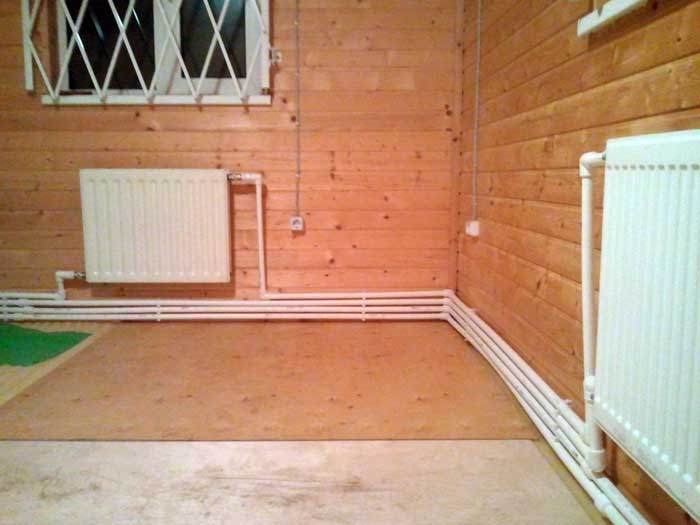
One of the options for laying pipes in a frame house
What are the benefits of electric heating?
Bringing a highway to a site is expensive, so many homeowners are looking for other options. The use of liquid fuel boilers is not suitable for everyone, because a special container is needed to store diesel fuel. But heating a wooden house with electricity is a worthy solution to the problem. What is the rationale for this? There are many arguments:
- boilers operating on electrical energy have a number of significant advantages. This includes operational safety, compactness, efficiency, noiselessness, and environmental friendliness. Electric boilers fit perfectly into the interior as they have an elegant appearance. In addition, the equipment is equipped with automation. With the help of “smart” devices, the temperature in the rooms is regulated, energy saving is ensured and control is carried out from a distance;
- water heating - double-circuit boilers are used for this purpose;
- large selection of radiators - heating batteries for a wooden house are presented in a wide range: aluminum, steel, bimetallic. Leading manufacturers pay close attention to product quality and develop interesting ideas. Aluminum batteries last a long time and have fast heat dissipation. Steel radiators are affordable, while bimetallic ones can withstand high pressure.
When considering options for heating a wooden house with electricity, you need to say a few words about the use of heaters. Basically, electrical appliances are used as additional sources. They are classified according to the nature of heat transfer. Electric heating in a wooden house is provided using different heaters:
- Oil radiators - they do not irritate the respiratory system.
- Convectors are portable devices whose operating principle is based on the passage of air from the bottom panel to the top through a heating element.
- IR devices are heaters that have a positive effect on the body.
The use of electric heating in a wooden house
The use of electrical appliances to heat a house made of timber is a fairly common solution. First of all, electric boilers are the most popular. They have a special tubular element (heating element) that allows you to quickly convert electrical energy into heat. The heating element is located in a large container of the heating boiler, and in contact with the main coolant, it heats it up quite quickly. In turn, the coolant, moving along the circuit of the system, transfers thermal energy to the heating elements.
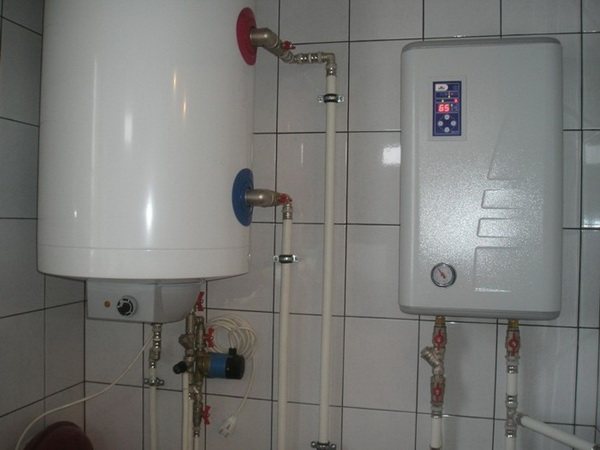
Electric boiler
Of course, the modern market offers users a large number of electrical appliances, through the use of which it is possible to create the most comfortable temperature in the house. The most common devices include air heaters, UV heaters, and oil radiators. Each of these devices has both significant advantages and quite serious disadvantages.
Perhaps the most significant disadvantage of all electric heating devices is their high level of energy consumption.
That is, if you constantly use electrical appliances to heat your home, you will have to pay quite large amounts for electricity. In addition, power outages are quite common in country houses. At the same time, it should be recognized that heating a log house through the use of electrical appliances is the only way out for those who do not have the opportunity to connect to the gas mains due to its distance from the house.
Heating with solid fuel is a proven method
If there is no gas main nearby, and electricity is not suitable due to the high cost, there is no need to worry. Heating a wooden house using a boiler that runs on wood or coal is an excellent option. For many years, our ancestors used these types of fuel to create a comfortable atmosphere in their homes. Therefore, there is nothing shameful here.
It is worth paying attention: it is better to entrust the installation of heating in a wooden house to specialists with relevant experience and knowledge. But if a person has practical skills, he can do everything on his own.
The heating system in a wooden house is installed in several stages:
- project development - a series of calculations are performed, power and other parameters are determined;
- selection of equipment, materials, components;
- preparation of the boiler room - this room must comply with safety standards;
- boiler installation;
- laying a pipeline - the heating circuit in a wooden house can be single- or double-circuit;
- installation of radiators - devices are mounted in the wall and connected to the pipeline;
- commissioning - the system is checked for leaks.
This heating option is a completely autonomous system, so it is widely used in areas where there are problems with gas and electricity. Solid fuel boilers are conventionally divided into four groups: pyrolysis, classic, universal, long-burning.
The heating system for a wooden house with a solid fuel boiler is often used, because modern equipment has significant advantages:
- safety;
- reliability of operation;
- long service life;
- controlling the combustion process.
This is important to know: such boilers have some disadvantages. We are talking about periodic reloading of fuel and the need for a room for storing firewood, coal or pellets.
Gas holders are a good alternative
How to heat a wooden house if it is not connected to a central gas supply system? There is a worthy answer to this question: you need to use a metal tank designed for storing liquefied propane-butane. Such containers are made of high-strength steel coated with an insulating agent. Shut-off and control valves are installed on the top cover of the tanks, consisting of a fill level indicator and valves.
Heating a wooden house using a gas holder is an excellent solution, because such a system is completely autonomous. Other advantages should also be mentioned:
- safety – metal tanks are certified for use in our country;
- good performance - gas tanks are installed in a horizontal position, which increases the area of fuel evaporation;
- aesthetics - the container is located underground. The tank lid can be decorated with artificial stone;
- a gas holder for heating a house is best suited because it does not require frequent refueling;
- environmental friendliness - when using steel containers with fuel, the environment is not heavily polluted.
This is important to know: installation and regular maintenance of tanks must be carried out by qualified specialists.
The disadvantage of this method is the high cost of equipment and installer services. But if people have no other choice, this method is quite acceptable.
Regardless of the chosen option, to ensure that the system functions stably and there are no unpleasant surprises, it is better to entrust the heating installation in a wooden house to professionals. Specialists use time-tested schemes, select high-quality materials and perform their work competently.
teploguru.ru
Factors influencing the choice of heating type
There are different options for heating systems for wooden houses. When choosing one type or another, you need to take into account a number of factors.
The most important of them is the high flammability of wood. This means that all safety measures must be strictly observed when installing heating in a house made from this building material. It doesn’t matter that each log or beam is treated with fire retardant impregnations, the fire hazard remains.
Heating scheme for a private house
It is also necessary to take into account whether constant heating of a wooden house is necessary. If this is a country house, then it may only have to be heated for a short time when people are there. In this case, there is no need to install an expensive heating system.
If the choice falls on a heating system using electrical appliances, then it is necessary to take into account the procedure for power supply to the territory where the housing is located. You may have to get an electric generator. Its power is chosen depending on how stable or unstable the supply of electricity is and how much area will need to be heated.
When designing the heating of a wooden house, it is very important to take into account its design features. The design of the heating system must be created taking into account not only the type of wall materials, but also the types of floors and the layout of the building. After all, the heating system in a brick house is significantly different from a similar system in a wooden house.
Heating diagram for a 2-storey house
Types of heating systems for wooden houses
Heating of a wooden house can be organized using electric, gas or solid fuel boilers. Stove heating can be used.
We will not consider options for heating rooms using various types of heaters such as UFO or oil radiators. This heating system is suitable only for those cases when a wooden house is used for short-term stays and not for permanent residence.
Stove in a wooden house
If you decide to organize stove heating in your house with your own hands, then the first thing that needs to be taken into account is the foundation for the stove.
It should be organized separately from the foundation of the house and not be connected to it.
Russian stove
For fire safety purposes, the walls of the firebox should never come into contact with the wooden walls of the house. The Russian stove (its combustion part) must be at least 15 cm away from the walls. The chimney must be built without the slightest defect and carefully insulated with non-combustible materials, especially in places where it passes through wooden structures.
A real Russian stove is a rather massive structure. It occupies most of the interior space of the house. If you build a small stove, it is unlikely to be able to perform its direct heating function.
Stove heating is usually not installed in houses of more than one floor. Otherwise, a separate stove will be needed on each floor.
Since the oven is a rather complex structure, it is better not to try to make it yourself. The risk is very high, and the consequences of unprofessional work can be fatal.
Water heating
Water heating in a wooden house also has its own nuances.
Houses made of wood materials shrink significantly over time. This fact must be taken into account when laying communications for water heating. To compensate for shrinkage, special compensatory loops are made in the pipes. They prevent pipes from bursting or deforming.
Schemes for laying main pipes for water heating can be either open or hidden. An open layout spoils the interior of the premises. Often water heating pipes in wooden houses are laid in an open way.
When the floor of the house is built on joists, the pipes can be hidden underneath without making significant cuts. But it should be taken into account that the coolant - the water in the pipes - will cool faster. This will require increased heating costs.
It is quite possible to make water heating wiring diagrams for a house on your own. You can even lay heating lines yourself. Especially if you use flexible polypropylene pipes.
The heat source for a water heating system can be a gas, electric or solid fuel boiler. Each of them has its own advantages and disadvantages.
Of all types, gas heating is the most economical. But to install a gas boiler you must obtain a special permit. It is also important to install gas pipes and chimney correctly. Doing this yourself, without the participation of a master, is not only not recommended, but also not permitted by law.
The easiest to install is an electric boiler with automatic control. But this is an expensive heating system.
What heating is best for a wooden house?
Nowadays, private houses continue to gain popularity among residents of big cities and metropolises. One of these cities is St. Petersburg, from which residents continue to leave to live in small villages and suburbs. The reason here is the desire to take a break from the busy life in the metropolis and get rid of stress. To do this, people buy or build houses for themselves, in which they can live both permanently and spend their holidays there. Each house is built from a certain type of material, and in this article we will discuss in more detail the material of the house, as well as its connection with the heating system.
Wooden houses and their features
Today, wooden houses are increasingly being built within the Leningrad region. The reason for this is the following types of benefits:
- Complete safety for people living in this house
- Ease of construction
- When using the services of designers, a wooden house can be a work of art
But at the same time, this type of house has its own characteristics:
- Dependence on humidity in the house
- Dependence on temperature difference
- Poor thermal conductivity
- Fire Hazard
It is a wooden house that requires unique and careful care in order to ensure warmth in it throughout the winter period.
Selecting a heating system
To choose a heating system for a wooden house, you must take into account 3 main factors that this system must comply with:
- Safety for people living in the house. This means that the heating system in the house must be organized in such a way that all residents of the house are safe.
- Fire safety. Since a wooden house has a high risk of fire, you must install the system in such a way that the house does not catch fire.
- Economical. The system must be economical so that the home owner pays as little as possible for heating.
- Efficiency. Perhaps the most important factor, which, together with economy, forms an efficiency indicator. This indicator determines the efficiency of heating a house at the minimum cost.
It is based on the efficiency indicator that you should choose a heating system for a private home. Nowadays, there are 2 main types of heating for a wooden house: electric heating and gas.
Gas heating
Gas heating systems are widely used today for wooden houses. This is due to the following advantages:
- You do not have to allocate the space in which the fuel will be stored, provided that the main pipeline is used
- Modern equipment allows you to program the heating system in order to create a certain constant temperature in the house
- If you use double-circuit heating, then it becomes possible to provide your home not only with water, but also with hot water
- Not very high cost for equipment installation
Electric heating
This method is also often used for wooden houses, and has the following advantages:
- You can install this type of equipment if the gas main is inaccessible
- Fairly simple installation
- Intuitive to use
- High efficiency
System selection
For a wooden house, the heating system is selected individually and taking into account the above advantages. We advise you to consult with experienced people or contact an organization that deals with these issues. Our company is such an organization, whose employees will help you decide on the choice of heating systems for a wooden house.
Source:
Source:
Source:

